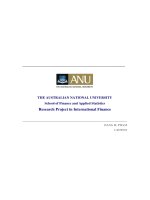Metamorphic facies and metamorphosed mafic rocks
Bạn đang xem bản rút gọn của tài liệu. Xem và tải ngay bản đầy đủ của tài liệu tại đây (2.88 MB, 82 trang )
Metamorphic Facies and
Metamorphosed Mafic Rocks
V.M. Goldschmidt (1911, 1912a), contact
metamorphosed pelitic, calcareous, and
psammitic hornfelses in the Oslo region
Relatively simple mineral assemblages (< 6 major
minerals) in the inner zones of the aureoles
around granitoid intrusives
Equilibrium mineral assemblage related to X
bulk
Metamorphic Facies
Certain mineral pairs (e.g. anorthite + hypersthene)
were consistently present in rocks of appropriate
composition, whereas the compositionally
equivalent pair (diopside + andalusite) was not
If two alternative assemblages are X-equivalent,
we must be able to relate them by a reaction
In this case the reaction is simple:
MgSiO
3
+ CaAl
2
Si
2
O
8
= CaMgSi
2
O
6
+ Al
2
SiO
5
En An Di Als
Metamorphic Facies
Pentii Eskola (1914, 1915) Orijärvi, S. Finland
Rocks with K-feldspar + cordierite at Oslo
contained the compositionally equivalent pair
biotite + muscovite at Orijärvi
Eskola: difference must reflect differing physical
conditions
Finnish rocks (more hydrous and lower volume
assemblage) equilibrated at lower temperatures
and higher pressures than the Norwegian ones
Metamorphic Facies
Oslo: Ksp + Cord
Orijärvi: Bi + Mu
Reaction:
2 KMg
3
AlSi
3
O
10
(OH)
2
+ 6 KAl
2
AlSi
3
O
10
(OH)
2
+ 15 SiO
2
Bt Ms Qtz
= 3 Mg
2
Al
4
Si
5
O
18
+ 8 KAlSi
3
O
8
+ 8 H
2
O
Crd Kfs
Metamorphic Facies
Eskola (1915) developed the concept of
metamorphic facies:
“In any rock or metamorphic formation which has
arrived at a chemical equilibrium through
metamorphism at constant temperature and pressure
conditions, the mineral composition is controlled only
by the chemical composition. We are led to a general
conception which the writer proposes to call
metamorphic facies.”
Metamorphic Facies
Dual basis for the facies concept
1.Descriptive: relationship between the X
bulk
& mineralogy
•
A fundamental feature of Eskola’s concept
•
A metamorphic facies is then a set of repeatedly
associated metamorphic mineral assemblages
•
If we find a specified assemblage (or better yet, a
group of compatible assemblages covering a range of
compositions) in the field, then a certain facies may
be assigned to the area
Metamorphic Facies
2. Interpretive: the range of temperature and pressure
conditions represented by each facies
•
Eskola aware of the P-T implications and correctly
deduced the relative temperatures and pressures of
facies he proposed
•
Can now assign relatively accurate temperature and
pressure limits to individual facies
Metamorphic Facies
Eskola (1920) proposed 5 original facies:
•
Greenschist
•
Amphibolite
•
Hornfels
•
Sanidinite
•
Eclogite
Easily defined on the basis of mineral assemblages
that develop in mafic rocks
Metamorphic Facies
In his final account, Eskola (1939) added:
•
Granulite
•
Epidote-amphibolite
•
Glaucophane-schist (now called Blueschist)
and changed the name of the hornfels facies to
the pyroxene hornfels facies
Metamorphic Facies
Fig. 25.1 The metamorphic facies proposed by Eskola and their relative temperature-pressure
relationships. After Eskola (1939) Die Entstehung der Gesteine. Julius Springer. Berlin.
Metamorphic Facies
Several additional facies types have been proposed.
Most notable are:
•
Zeolite
•
Prehnite-pumpellyite
from Coombs in the “burial metamorphic” terranes of
New Zealand
Fyfe et al. (1958) also proposed:
•
Albite-epidote hornfels
•
Hornblende hornfels
Metamorphic Facies
Fig. 25.2.
Fig. 25.2.
Temperature-
Temperature-
pressure diagram showing
pressure diagram showing
the generally accepted
the generally accepted
limits of the various facies
limits of the various facies
used in this text.
used in this text.
Boundaries are
Boundaries are
approximate and
approximate and
gradational. The “typical”
gradational. The “typical”
or average continental
or average continental
geotherm is from Brown
geotherm is from Brown
and Mussett (1993).
and Mussett (1993).
Winter
Winter
(2010) An Introduction to
(2010) An Introduction to
Igneous and Metamorphic
Igneous and Metamorphic
Petrology. Prentice Hall.
Petrology. Prentice Hall.
Metamorphic Facies
Table 25.1. The definitive mineral assemblages that
characterize each facies (for mafic rocks).
Facies Definitive Mineral Assemblage in Mafic Rocks
Zeolite zeolites: especially laumontite, wairakite, analcime
Prehnite-Pumpellyite prehnite + pumpellyite (+ chlorite + albite)
Greenschist chlorite + albite + epidote (or zoisite) + quartz ± actinolite
Amphibolite hornblende + plagioclase (oligoclase-andesine) ± garnet
Granulite orthopyroxene (+ clinopyrixene + plagioclase ± garnet ±
hornblende)
Blueschist glaucophane + lawsonite or epidote (+albite ± chlorite)
Eclogite pyrope garnet + omphacitic pyroxene (± kyanite)
Contact Facies
After Spear (1993)
Table 25-1
. Definitive Mineral Assemblages of Metamorphic Facies
Mineral assemblages in mafic rocks of the facies of contact meta-
morphism do not differ substantially from that of the corresponding
regional facies at higher pressure.
It is convenient to consider metamorphic facies in 4 groups:
1) Facies of high pressure
•
The blueschist and eclogite facies: low molar volume
phases under conditions of high pressure
•
Blueschist facies- areas of low T/P gradients:
subduction zones
•
Eclogites: stable under normal geothermal conditions
Deep crustal chambers or dikes, sub-crustal magmatic
underplates, subducted crust that is redistributed into the
mantle
Metamorphic Facies
2) Facies of medium pressure
•
Most exposed metamorphic rocks belong to the
greenschist, amphibolite, or granulite facies
•
The greenschist and amphibolite facies conform to the
“typical” geothermal
gradient
Metamorphic Facies
•
3) Facies of low pressure
•
Albite-epidote hornfels, hornblende hornfels, and
pyroxene hornfels facies: contact metamorphic
terranes and regional terranes with very high
geothermal gradient.
•
Sanidinite facies is
rare- limited to
xenoliths in basic
magmas and the
innermost portions of
some contact aureoles
adjacent to hot basic
intrusives
Metamorphic Facies
•
Zeolite and prehnite-
pumpellyite facies not
always represented,
and greenschist facies
may be the lowest
grade developed in
many regional terranes
•
4) Facies of low grades
•
Rocks may fail to recrystallize thoroughly at very low
grades, and equilibrium not always attained
Metamorphic Facies
Combine the concepts of isograds, zones, and facies
•
Examples: “chlorite zone of the greenschist facies,” the
“staurolite zone of the amphibolite facies,” or the
“cordierite zone of the hornblende hornfels facies,” etc.
•
Metamorphic maps typically include isograds that
define zones and ones that define facies boundaries
•
Determining a facies or zone is most reliably done
when several rocks of varying composition and
mineralogy are available
Fig. 25.10. Typical mineral changes that take place in metabasic rocks during progressive metamorphism in the medium
P/T facies series. The approximate location of the pelitic zones of Barrovian metamorphism are included for comparison.
Winter (2010) An Introduction to Igneous and Metamorphic Petrology. Prentice Hall.
Facies Series
A traverse up grade through a metamorphic terrane should
follow one of several possible metamorphic field gradients
(Fig. 21.1), and, if extensive enough, cross through a
sequence of facies
Figure 21.1. Metamorphic field gradients (estimated P-T conditions along surface traverses directly up metamorphic grade) for several
metamorphic areas. After Turner (1981). Metamorphic Petrology: Mineralogical, Field, and Tectonic Aspects. McGraw-Hill.
Facies Series
Miyashiro (1961) proposed five facies series, most of them
named for a specific representative “type locality” The
series were:
1. Contact Facies Series (very low-P)
2. Buchan or Abukuma Facies Series (low-P
regional)
3. Barrovian Facies Series (medium-P regional)
4. Sanbagawa Facies Series (high-P, moderate-T)
5. Franciscan Facies Series (high-P, low T)
Fig. 25.3.
Temperature-
pressure diagram
showing the three
major types of
metamorphic facies
series proposed by
Miyashiro (1973,
1994). Winter
(2010) An
Introduction to
Igneous and
Metamorphic
Petrology. Prentice
Hall.
Metamorphic Facies
Figure 25.4.
Schematic cross-section of an island arc illustrating isotherm depression along the outer belt and elevation along the inner
Schematic cross-section of an island arc illustrating isotherm depression along the outer belt and elevation along the inner
axis of the volcanic arc. The high P/T facies series typically develops along the outer paired belt and the medium or low P/T series
axis of the volcanic arc. The high P/T facies series typically develops along the outer paired belt and the medium or low P/T series
develop along the inner belt, depending on subduction rate, age of arc and subducted lithosphere, etc. From Ernst (1976).
develop along the inner belt, depending on subduction rate, age of arc and subducted lithosphere, etc. From Ernst (1976).
Metamorphism of Mafic Rocks
Mineral changes and associations along T-P gradients
characteristic of the three facies series
•
Hydration of original mafic minerals generally required
•
If water unavailable, mafic igneous rocks will remain largely
unaffected, even as associated sediments are completely re-
equilibrated
•
Coarse-grained intrusives are the least permeable and likely to
resist metamorphic changes
•
Tuffs and graywackes are the most susceptible









